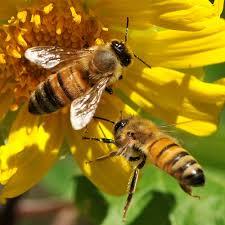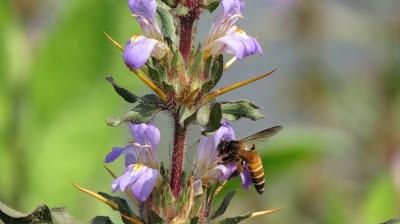El néctar es una solución acuosa, de una humedad que ronda desde el 30 al 70 %, que las plantas producen a través de sus glándulas nectarinas, generalmente ubicadas en la base de la flor.
Las abejas pueden percibir el aroma y la calidad del néctar de las flores mediante sus antenas.
El trabajo de recolección empieza cuando la temperatura es lo suficientemente alta (13ºC) como para que el frío no entumezca sus alas y puedan batirlas.  Esto en primavera y verano ocurre a partir de primeras horas de la mañana, por lo que es normal que comiencen su actividad al poco de amanecer, prolongándola casi hasta el oscurecer.La abeja succiona el néctar de los nectarios de las flores y éste es depositado en el buche melario que tiene en la región torácica.Las abejas pueden distinguir la edad, el tipo y el estado de las flores, eligiendo así el néctar adecuado en cada momento.Dependiendo de la planta de donde proviene, consiste fundamentalmente de una solución de varios azúcares, compuestos nitrogenados, minerales, ácidos orgánicos, vitaminas, pigmentos y sustancias aromáticas que están presentes sólo en concentraciones bajas.Cuando un abeja elige una planta se posa sobre ella e ingiere la mayor cantidad posible de néctar, que luego transporta hasta la colmena.La producción de néctar no es continua, varia conforme a las condiciones florales de cada planta, a las características climáticas y a la intensidad del brillo solar de una zona en particular.
Esto en primavera y verano ocurre a partir de primeras horas de la mañana, por lo que es normal que comiencen su actividad al poco de amanecer, prolongándola casi hasta el oscurecer.La abeja succiona el néctar de los nectarios de las flores y éste es depositado en el buche melario que tiene en la región torácica.Las abejas pueden distinguir la edad, el tipo y el estado de las flores, eligiendo así el néctar adecuado en cada momento.Dependiendo de la planta de donde proviene, consiste fundamentalmente de una solución de varios azúcares, compuestos nitrogenados, minerales, ácidos orgánicos, vitaminas, pigmentos y sustancias aromáticas que están presentes sólo en concentraciones bajas.Cuando un abeja elige una planta se posa sobre ella e ingiere la mayor cantidad posible de néctar, que luego transporta hasta la colmena.La producción de néctar no es continua, varia conforme a las condiciones florales de cada planta, a las características climáticas y a la intensidad del brillo solar de una zona en particular.
 Generalmente, las abejas retornan varias veces a la misma planta hasta que consumen todo el néctar que contiene.
Generalmente, las abejas retornan varias veces a la misma planta hasta que consumen todo el néctar que contiene.
Este proceder es adecuado porque la obrera reduce los tiempos y la energía necesaria para realizar los transportes.Se ha comprobado que en ocasiones la abeja liba un tipo de planta por la mañana u otro diferente por la tarde. Este comportamiento responde a que las distintas flores tienen diferentes horarios para segregar su néctar y la necesidad de aprovechar mejor el trabajo de libar.También, tomando en cuenta estas características, el néctar tendrá variantes y, por ende, la miel derivada de este también las tendrá. El sabor y las propiedades de la miel dependen de las fuentes nectarias Por eso la miel de diferentes regiones y de distintos períodos de afluencia de néctar tiene variaciones de sabor y color.
Collecting nectar (English)
The nectar is an aqueous solution of a round humidity from 30 to 70%, the plants produced through its nectaríferas gland generally at the base of the flower.
Bees can smell the aroma and quality of flower nectar using their antennae.
The collection starts working when the temperature is high enough (13 ° C) so that the cold can numb their wings and beat them. This occurs in spring and summer from early in the morning, so it is normal to start up shortly after sunrise, prolonging almost until dark.The bee sucking nectar from the nectaries of flowers and it is deposited in the crop melario having in the thoracic region.Bees can distinguish the age, type and condition of the flowers, thus choosing the appropriate nectar at all times.Depending on the plant from which consists essentially of a solution of various sugars, nitrogen compounds, minerals, organic acids, vitamins, pigments and aromatic substances are present only in low concentrations.When a bee alights choose a plant on it and eat as many of nectar, which is then transported to the hive.Nectar production is not continuous, varies according to the conditions of each plant flowers, to the climatic characteristics and intensity of sunshine in a particular area.Generally, bees returning several times to the same plant until they consume all the nectar it contains. This approach is appropriate because the working reduces the time and energy needed for transport.It has been found that sometimes the bee sucks a type of plant in the morning or different afternoon. This behavior reflects the fact that different flowers have different schedules to secrete their nectar and the need to get more work suck.Also, taking into account these features, the nectar will variants and therefore honey derived from this also will. The flavor and properties depending on the sources honey nectar. So honey from different regions and different periods of nectar flow has flavor and color variations.
-----------------------------------------------------------------------------------------------------------------------------VISITA ESTE SITIO. FOMENTA EL CONSUMO DE MIEL Y DIFUNDE LA ACTIVIDAD APÍCOLA.
